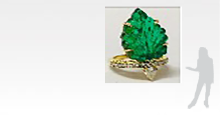
The ring is designed with a full-cut diamond band flanked with a carved emerald on one side and a pear-shaped diamond on the other side, mounted in gold.
Emerald: 19.68 carats
Diamond: 0.82 carats
Gross weight: 10.12 grams
Ring size: American 6 1/2, English M 1/2
Gem carving is an ancient jewellery art form where precious or semi-precious stones were given intricate sculptural detail through engraving or relief carving. During ancient times, the gem cutters etched out patterns, motifs, images or inscriptions using flat-edged wheels or round-tipped drills. Jaipur, Rajasthan and Khambhat, Gujarat are considered as gemstone carving hubs in India, where master cutters have and continue to pass on their expertise and legacies to the next generation.
In India, the carved motifs and patterns included symbols from nature, such as floral designs which were reflective of traditional Indian architecture. During the Mughal period, the Taj Mahal, with its exquisitely detailed marble carvings of flowering vines, proved to be a great source of inspiration for gem cutters. Emeralds were particularly coveted in India, because they were rare for the region. The stones poured into India through Goa and the Deccan ports, exported from South America by Portuguese traders. "The lapidaries of India were master cutters and workers of stones, as is exemplified by their magnificent and delicate carvings of emerald beads and tablets. A rough crystal would be superbly cut to achieve the maximum depth of colour." (Joanna Hardy, "The Jeweller's Art," Emerald: Twenty-one Centuries of Jewelled Opulence and Power, Robert Violette ed., London: Violette Limited and Gemfields PLC, 2013, p. 98)
Some well-known examples of carved gemstones can be seen in the jewellery designs of Cartier, which has been famously influenced by Indian jewellery since Jacques Cartier first arrived in India to attend the Delhi Durbar in 1911. He saw India as an opportunity to secure clients, which included the Nizam of Hyderabad, the Maharajas of Patiala, Kapurthala and Nawanagar, the Begum of Bhopal and Aga Khan; as well a rich source for acquiring gemstones and pearls. By the 1920s, even as French jewellers shifted from the floral and ornate designs of the Art Nouveau period into Art Deco aesthetics, "Cartier made the spirit of the Maharajah's jewelry and India very much a part of its new look. Suddenly the collection that had been all about diamonds, pearls and platinum was infused with colorful cabochons and carved gems. There was lots of movement in the jewels. Some of Cartier's motifs echoed shapes in traditional Mughal treasures." (Marion Fasel, "How India Inspired Cartier," The Adventurine, online)
Other similar works in:
this auction
|
entire site

Lot
118
of
174

FINE JEWELS: ODE TO NATURE
15-16 OCTOBER 2019
Estimate
Rs 9,00,000 - 10,00,000
$12,860 - 14,290
Winning Bid
Rs 8,88,720
$12,696
(Inclusive of Buyer's Premium)

Size Size

Height of Figure: 6'